Tamron Blogs
More Photo Tips | Video Gallery | Photo Gallery | Enewsletter sign-up
Wildlife Photography Tips and Why the Tamron 150-500mm Lens Works for Me
Text & Images by Don Mammoser
Long before I ever got into photography I was interested in wildlife. As a child I
remember keeping lists while on family vacations, of all the wildlife I saw. Then, 25
years ago as I worked towards becoming a professional nature photographer,
wildlife was certainly one of my favorite subjects to point a camera at. Since those
days, cameras and lenses have gotten better and better, enabling us wildlife
photographers to improve our images exponentially. I certainly place Tamron’s
150-500mm lens in the category of excellent tools for the job. This lens’ features
such as nice zoom range, quick and accurate focusing, and incredible sharpness
all add up to make me one really happy wildlife photographer.
Here are some of my wildlife photography tips and why I often use the Tamron
150-500mm lens on my Sony cameras.

150mm, f/5.0, 1/1000 sec., ISO 2000
Click image to view larger
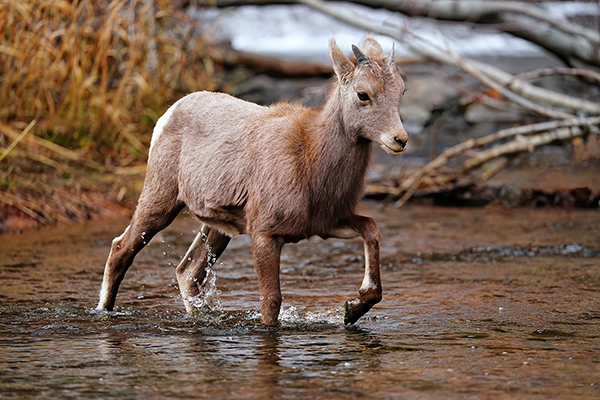
368mm, f/5.6, 1/1000 sec., ISO 2000
Click image to view larger
Here was a situation where the Tamron lens was a perfect choice over any of my
other wildlife lenses. I knew about this area in Colorado where Bighorn Sheep are
often seen during the winter. The issue for interested wildlife watchers and
photographers is one of access. The Bighorn are found up a steep dirt road where
the only way to get there is via hiking or biking. I chose to ride my mountain bike
and brought the Tamron lens because at just 3.8 pounds, it is a lot lighter and also
quite a bit smaller than my other lenses. Lighter weight gear just makes more
sense when riding a bike off-road to get somewhere. Still, I wanted the nice zoom
range of 150-500mm so as not to spook the Bighorn Sheep should I find them.
When I did find the animals they were all bunched up as a family group and I took
several images such as the one shown here. Whenever photographing multiple
animals in a group try and wait for all (or most) of the animals to raise their heads
and also try and time your shooting for when there is bit of separation between
heads or bodies. Then, anticipate what might happen next. The bighorn started to
cross the river one at a time and this provided me with even better images as in
the one above. The young Bighorn is separated from the group and he has lots of
motion in his legs, yet my shutter speed was fast enough to stop the splashing
water and the movement of the animal.
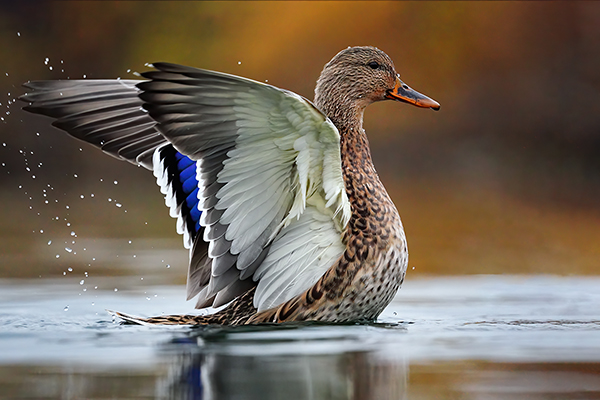
500mm, f/5.7, 1/1250 sec., ISO 12800
Click image to view larger

500mm, f/6.7, 1/1000 sec., ISO 8000
Click image to view larger
There are several things to learn from either of these images and again the Tamron
150-500mm lens worked perfectly. In both images the main lesson is to get low.
This applies to any wildlife subject - you’ll always get more appealing and intimate
images if you get down to the subjects eye level. Oftentimes this isn’t easy to do
and with waterfowl sitting on water it is especially challenging. Having the
lightweight Tamron wildlife lens helps. For such images I’ll sit at the lakeside and
use my flip-out screen on my Sony camera, I compose and shoot using that LCD
screen rather than my viewfinder. I place camera and lens on either my
outstretched leg or on my home-made ground pod placed at water level. The fast
focus of the Tamron lens helps a lot. In the sitting duck image, the female Mallard
was slowly drifting past me and I loved the colorful background, which was autumn
colored trees on the other side of the lake. Getting low like this gets you those
amazing backgrounds. In the wing stretch image I also got low to achieve that nice
background. Another tip here (and repeated from above) is to try and anticipate
what might happen. This duck began dunking her head and wings in the water and
I knew from watching ducks a lot that this meant a wing stretch was coming next.
Again, the fast focus of the Tamron lens ensured that I got the image I wanted.
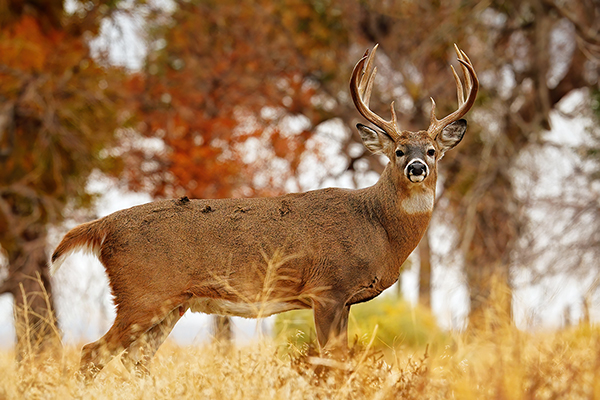
301mm, f/6.3, 1/500 sec., ISO 1600
Click image to view larger
This is an amazingly perfect and huge Whitetail Deer. This male is in prime
breeding condition and this image was taken during the fall rut when large
ungulates such as deer, elk and moose look their best. My photo tip here is to
adjust what subjects you’ll go after by timing it with nature in mind. Obviously if
you want baby animal images then Springtime is best. If, like in this image, your
goal is impressive males, then the Autumn season works best. A deer like this isn’t
easy to sneak up on normally, but I knew of an area where wildlife are protected
and that offered a ‘wildlife drive’ feature. The deer at this refuge pretty much
ignore vehicles and so I used my car as a moving blind, driving around until I
spotted this deer. The zoom range of the Tamron 150-500mm was wonderful to
have at my fingertips. This image was taken at 300mm and if I only had a single
focal length 500mm or 600mm lens with me I’d have missed the shot.
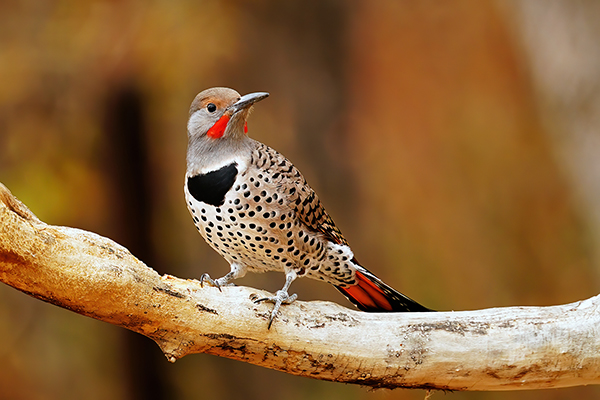
500mm, f/6.7, 1/250 sec., ISO 800
Click image to view larger
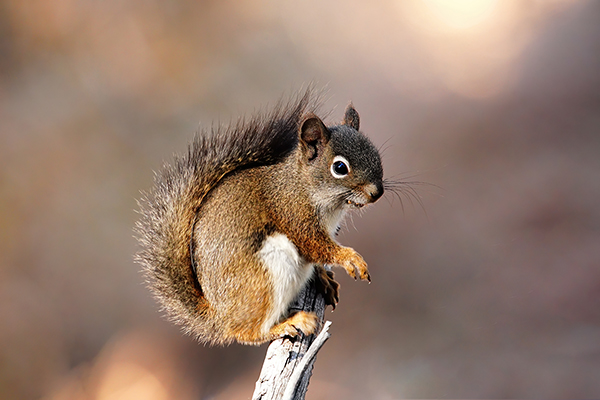
500mm, f/6.7, 1/250 sec., ISO 1600
Click image to view larger
Both of these images are basically “animal-on-a-stick” shots. But both have a
couple of things we can learn when trying to get better wildlife photographs. The
first thing I’d say is that even ‘common’ species such as a squirrel can make for
cool images. This type of squirrel can be found all over North America, but I like
this image because the animal is looking directly at the camera and the raised foot
offers a nice implied motion of where the squirrel might go next. Plus squirrels are
just plain cute! In the Northern Flicker image, we can see that the Tamron lens
offers sharpness that years ago I could only have dreamed about. The feather
detail in this image is fantastic. In both images I worked hard on camera placement
so I’d have a background with nice ‘bokeh’ or out-of-focus areas. The main way to
control your background is to photograph a subject that is relatively far from said
background. In the squirrel image my background was a pine-tree forested hillside.
I positioned myself in such a way as to minimize the sunny areas that were back
there. In the bird image my background was a row of fall-colored trees. Again I
tried to get my camera and the Tamron lens in a spot which minimized background
distractions.
I have 2 Sony camera bodies which I use for wildlife photography, a full-frame and
an APS-C sensor camera. The Tamron 150-500mm lens works flawlessly on both.
With my APS-C camera the equivalent focal length is 225-750mm - a LOT of zoom
power! As a long-time professional photographer and photo tour leader, I can
honestly say that the Tamron 150-500mm lens offers super fast and accurate
focusing, pin-sharp detail, nice ergonomics, and it all comes in a lighter weight
form-factor that I find priceless. Now I can’t wait for Spring to arrive so I can get
outside and photograph some baby animals.
To see more of Don Mammoser's work visit his website, YouTube or Instagram.
More Photo Tips | Watch Videos | Learn More About Tamron Lenses | Photo Gallery